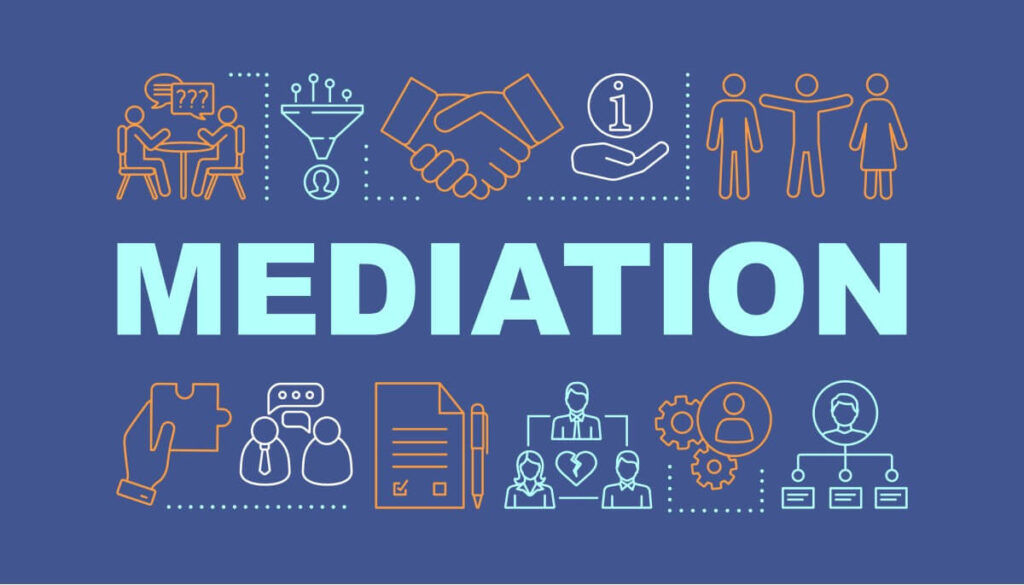Steering Clear of the Courtroom: Navigating Smooth Paths to Conflict Resolution
Alternative Dispute Resolution (ADR) has emerged as a powerful and effective mechanism for resolving conflicts outside the traditional courtroom setting. By providing parties with more control over the process and outcomes, ADR methods like mediation, arbitration, and negotiation offer a promising alternative to lengthy and costly litigation. In this comprehensive article, the reader will embark on a journey to explore the diverse landscape of ADR, understanding how mediation, arbitration, and negotiation facilitate collaborative resolution in various disputes. With an emphasis on its benefits, drawbacks, and real-life applications, this exploration aims to equip individuals and professionals alike with the knowledge to make informed decisions when faced with conflict.
As disputes can arise in various aspects of life, from business and family matters to community issues, this article delves into the intricacies of each ADR method, highlighting their unique advantages and challenges. By understanding the roles of mediators, arbitrators, and negotiators, as well as the techniques and approaches they employ, individuals can better navigate complex scenarios and foster productive dialogue. Furthermore, the comparison between ADR and litigation will shed light on the factors that influence the choice of dispute resolution method, allowing individuals to assess which approach aligns best with their goals and needs.
Mediation: Facilitating Collaborative Resolution

Mediation is a valuable tool for facilitating collaborative resolution in a wide range of conflicts. By understanding the mediation process, the roles of the mediator and parties involved, and the advantages it offers, individuals and organizations can embrace this effective alternative to litigation and promote constructive problem-solving.
Understanding the Mediation Process
Mediation is a voluntary and confidential dispute resolution method that empowers parties to collaboratively resolve conflicts with the assistance of a neutral third-party mediator. The mediation process typically follows these key stages:
- Introduction and Opening Statements: The mediator begins by introducing themselves and outlining the mediation process. Each party presents their opening statements, expressing their perspectives and desired outcomes.
- Information Gathering: The mediator encourages parties to share relevant information and identify the underlying issues causing the dispute. This stage aims to foster open communication and build understanding between the parties.
- Issue Identification and Clarification: The mediator helps identify the main issues of contention and ensures that both parties have a clear understanding of each other’s concerns.
- Generating Options and Brainstorming Solutions: With the mediator’s guidance, parties brainstorm potential solutions to address the identified issues. This creative exploration encourages parties to think beyond their initial positions and seek mutually beneficial outcomes.
- Negotiation and Agreement: The mediator facilitates negotiations and assists parties in reaching a consensus. If successful, the parties draft a formal agreement outlining the agreed-upon terms.
Role of the Mediator and Parties Involved
The mediator serves as a neutral facilitator, guiding the mediation process without imposing their opinions or solutions. Their role is to create a safe and constructive environment, encouraging open communication and assisting parties in finding common ground.
Mediators are skilled professionals trained in dispute resolution techniques. They remain impartial throughout the process, ensuring both parties are heard, and guiding the discussion towards a resolution.
Parties involved in mediation play an active role in finding solutions. They should be willing to communicate openly, actively listen to each other, and be open to compromise to reach a mutually acceptable resolution.
Advantages and Benefits of Mediation
Mediation offers numerous advantages over traditional litigation and other dispute resolution methods:
- Cost-Effective: Mediation is generally more cost-effective than going to court, as it reduces legal fees and associated expenses.
- Time-Efficient: Mediation can be quicker than traditional litigation, allowing parties to resolve their disputes promptly.
- Confidentiality: The mediation process is confidential, ensuring that sensitive information remains private.
- Empowerment and Control: Parties retain control over the outcome and actively participate in crafting their agreement.
- Preservation of Relationships: Mediation fosters a collaborative environment, which can preserve relationships between parties even after the resolution of the dispute.
Real-Life Examples of Successful Mediation
Mediation has proven successful in various contexts, resolving disputes in different fields:
- Workplace Conflicts: Mediation has helped resolve conflicts between employees, promoting a more harmonious and productive work environment.
- Family Disputes: Mediation is commonly used in divorce and child custody cases, enabling couples to reach agreements that consider the best interests of their children.
- Commercial Disputes: Mediation is employed in business-related conflicts, such as contract disputes and disagreements between business partners.
Arbitration: Adjudicating Disputes Outside the Courtroom
Arbitration offers a flexible and efficient means of resolving disputes, providing parties with greater control over the process and preserving privacy. Understanding the arbitration procedure, the role of the arbitrator, its advantages, drawbacks, and key differences from litigation can help individuals and businesses make informed decisions when selecting the most appropriate dispute resolution method for their specific situations.
Exploring the Arbitration Procedure
Arbitration has emerged as a popular alternative dispute resolution (ADR) method for resolving legal conflicts without resorting to traditional litigation. In arbitration, the parties involved agree to have a neutral third party, known as the arbitrator, review the evidence and hear arguments before rendering a final decision. The procedure generally involves the following steps:
- Agreement to Arbitrate: Before a dispute arises, parties often include an arbitration clause in their contracts, stipulating that any future disagreements will be settled through arbitration.
- Appointment of the Arbitrator: Once a dispute occurs, both parties mutually agree on an arbitrator or select one based on the rules specified in their contract or by an arbitration organization.
- Pre-Hearing Procedures: Prior to the hearing, both parties may exchange evidence, witness statements, and legal arguments, similar to the discovery process in litigation.
- Arbitration Hearing: During the arbitration hearing, both sides present their cases, call witnesses, and submit evidence. The arbitrator acts as a judge, listening to the arguments and evidence, and may ask questions to clarify points.
- Arbitrator’s Decision: After considering all the evidence, the arbitrator issues a final decision, known as the award. This decision is typically binding and enforceable, similar to a court judgment.
Selection and Authority of the Arbitrator
One of the significant advantages of arbitration is that parties have a say in choosing the arbitrator, which ensures that the individual is experienced and knowledgeable in the subject matter of the dispute. Parties can select a single arbitrator or a panel, depending on the complexity and significance of the case. Additionally, they can agree on the procedural rules that will govern the arbitration process.
The authority of the arbitrator is determined by the parties’ agreement or the arbitration rules in place. Typically, arbitrators have broad powers to manage the proceedings, hear evidence, and render a final decision. The arbitrator’s decision is often final and binding, with limited grounds for appeal.
Advantages and Drawbacks of Arbitration
Arbitration offers various advantages, making it an attractive option for dispute resolution:
- Efficiency: Arbitration usually takes less time than traditional litigation, as parties can avoid lengthy court procedures and backlogged dockets.
- Confidentiality: Unlike court proceedings, arbitration is generally confidential, protecting sensitive information and business secrets.
- Flexibility: Parties have the flexibility to customize the arbitration process to fit their needs, selecting the arbitrator, setting the hearing date, and choosing the location.
- Expertise: By choosing an arbitrator with expertise in the relevant field, parties can benefit from an adjudicator who understands the complexities of the subject matter.
However, there are also some drawbacks to consider:
- Limited Discovery: Unlike litigation, arbitration may have limited discovery, which could lead to incomplete information being presented.
- Limited Appellate Rights: The grounds for appealing an arbitration award are typically more limited than those for appealing a court judgment.
- Cost: While arbitration is often more cost-effective than litigation, it may still involve significant expenses, depending on the complexity of the case.
Key Differences Between Arbitration and Litigation
Arbitration and litigation are distinct in several aspects:
- Formality: Arbitration is less formal than litigation, offering a more relaxed setting for presenting evidence and arguments.
- Decision Maker: In arbitration, the decision-maker is a neutral arbitrator or panel, whereas in litigation, it is a judge or jury.
- Appeal Process: Arbitration awards generally have limited grounds for appeal, while court judgments can be appealed on more substantial legal issues.
- Publicity: Court proceedings are open to the public, while arbitration is usually private and confidential.
- Timeframe: Arbitration can be quicker, allowing for a faster resolution compared to the often protracted nature of litigation.
Negotiation: Finding Common Ground Through Dialogue

Understanding the different negotiation approaches, employing effective techniques, and navigating complex scenarios, negotiators can improve their skills and achieve more favorable outcomes. Emphasizing collaborative problem-solving can lead to agreements that benefit all parties involved and help build stronger relationships for future interactions.
Types of Negotiation Approaches
Negotiation is a fundamental skill used in various contexts, from business transactions to personal relationships. Different situations may call for different negotiation approaches. Here are some common types:
- Collaborative Negotiation: Also known as integrative negotiation, this approach focuses on problem-solving and finding mutually beneficial solutions. Parties involved work together to create value and expand the pie rather than competing over fixed resources.
- Competitive Negotiation: Also referred to as distributive negotiation, this approach involves parties seeking to maximize their gains at the expense of the other party. It typically centers on dividing fixed resources and involves more adversarial tactics.
- Compromising Negotiation: This approach involves a balance between assertiveness and cooperation. Parties seek to find middle ground by making concessions on certain issues to reach a settlement.
Techniques for Effective Negotiation
Successful negotiation requires a combination of communication, strategy, and interpersonal skills. Employing effective techniques can lead to positive outcomes for all parties involved. Some techniques include:
- Active Listening: Paying close attention to the other party’s interests and concerns fosters a better understanding and helps identify areas for compromise.
- Preparation and Research: Thoroughly researching the subject matter and understanding the other party’s needs and preferences provides a strong foundation for negotiations.
- Emotional Intelligence: Being aware of emotions and managing them effectively during negotiations can lead to more constructive dialogue and relationship-building.
- Offering Multiple Options: Presenting multiple solutions to the other party encourages them to consider alternatives and enhances the chances of reaching an agreement.
Navigating Complex Negotiation Scenarios
Negotiations can become intricate, especially when dealing with multiple parties, cultural differences, or high-stakes situations. Successfully navigating complex scenarios involves:
- Building Trust: Establishing trust and credibility is essential in complex negotiations. This can be achieved through open communication and transparency.
- Understanding Cultural Differences: In negotiations involving parties from diverse cultural backgrounds, awareness and respect for cultural differences can lead to smoother interactions.
- Managing Multiple Interests: In multi-party negotiations, understanding and addressing the interests of all parties is crucial to finding common ground and reaching a satisfactory agreement.
Integrative vs. Distributive Negotiation
The distinction between integrative and distributive negotiation lies in their primary focus and objectives.
Integrative Negotiation is an approach that seeks to create value and foster a win-win outcome for all parties. The focus is on collaboration, problem-solving, and expanding the potential for mutual gains.
In contrast, Distributive Negotiation distributive negotiation centers on dividing a fixed amount of resources. It tends to be more competitive, with parties seeking to maximize their share of the available resources.
ADR vs. Litigation: Comparing the Benefits and Drawbacks
When disputes arise, whether in business, family matters, or other legal conflicts, parties have various options for resolution. Two primary methods are Alternative Dispute Resolution (ADR) and traditional litigation. While both aim to achieve a fair resolution, they differ significantly in approach, process, and outcomes. Understanding the benefits and drawbacks of each approach can help individuals and organizations make informed decisions when choosing the most appropriate path for resolving their disputes.
Speed and Cost-Effectiveness
One of the most significant advantages of ADR is its speed and cost-effectiveness. Mediation and arbitration proceedings typically take less time than lengthy court trials. Parties can schedule sessions at their convenience, avoiding the lengthy court dockets and delays associated with litigation.
While litigation may offer a thorough and structured process, it often involves prolonged court proceedings. The legal process can be time-consuming, leading to higher costs due to attorney fees, court expenses, and expert witness fees.
Privacy and Confidentiality
ADR processes, particularly mediation, prioritize privacy and confidentiality. Parties involved in mediation are bound by confidentiality agreements, ensuring that sensitive information discussed during the sessions remains private and cannot be disclosed in court.
Litigation, on the other hand, operates in a public forum. Court records and proceedings are generally accessible to the public, leading to reduced privacy for the parties involved. Confidentiality may be challenging to maintain, potentially impacting personal or corporate reputations.
Control Over the Outcome
In ADR, parties have more control over the outcome of the dispute resolution process. Mediation and negotiation empower parties to actively participate in crafting mutually agreeable solutions that best fit their needs and interests.
In litigation, the outcome is ultimately determined by the judge or jury. While parties present their arguments, the final decision lies in the hands of the court. This lack of control over the outcome can lead to uncertainty and dissatisfaction for some parties.
Preserving Relationships and Reducing Animosity
ADR methods often focus on maintaining relationships and promoting amicable resolutions. Mediators and arbitrators strive to foster open communication and understanding between parties, enabling them to work together constructively in the future.
Litigation can be adversarial and contentious, pitting parties against each other in an effort to win the case. This adversarial nature of litigation may escalate tensions and strain relationships, making it challenging to rebuild trust after the dispute is resolved.
Choosing the Right ADR Method for Your Dispute

Choosing the right ADR method for a dispute requires a careful assessment of the nature of the dispute, the willingness to collaborate, the role of legal representation, and the desired binding or non-binding nature of the resolution. Each ADR method offers distinct advantages, and parties should consider their unique circumstances and objectives when selecting the most appropriate approach to resolve their dispute amicably and efficiently.
Assessing the Nature and Complexity of the Dispute
Alternative Dispute Resolution (ADR) methods offer parties an opportunity to resolve conflicts outside of traditional litigation, providing a more efficient and cost-effective approach. When choosing the right ADR method for a dispute, parties must first assess the nature and complexity of the issues involved. Different ADR techniques are better suited to specific types of disputes.
Mediation is a collaborative process where a neutral mediator facilitates communication between parties and helps them reach a mutually acceptable resolution. It is particularly effective for disputes where preserving relationships and maintaining control over the outcome are essential, such as family disputes or business conflicts.
Arbitration involves a neutral arbitrator who acts as a judge and makes a binding decision on the dispute. This method is suitable for complex disputes where parties prefer a final resolution and do not want to go through lengthy court proceedings.
Negotiation is the most informal ADR method, allowing parties to discuss and settle the dispute amongst themselves. It works well for less contentious and straightforward disputes, such as contract disputes or minor disagreements.
Considering the Willingness to Collaborate
The success of ADR heavily relies on the parties’ willingness to collaborate and engage in the resolution process. When choosing an ADR method, it is essential to consider the level of cooperation between the parties.
Mediation and negotiation are voluntary ADR methods, requiring both parties to willingly participate in the process and work towards finding a resolution together.
Meanwhile, some contracts or legal jurisdictions may require parties to engage in arbitration before proceeding to litigation. While arbitration is binding, parties must agree to arbitrate initially for this method to be effective.
The Role of Legal Representation in ADR

The involvement of legal representation can significantly impact the ADR process and its outcome. Parties may choose to have attorneys present during ADR sessions for various reasons:
- Legal Advice and Counsel: Attorneys provide valuable legal advice, helping parties understand their rights, obligations, and potential outcomes during ADR.
- Preparation and Strategy: Attorneys can help parties prepare for ADR sessions, strategize negotiations, and advocate for their best interests.
- Effective Communication: Lawyers can facilitate communication between parties, ensuring that each side’s concerns and positions are effectively conveyed.
Determining the Binding or Non-Binding Nature of ADR
Another critical consideration in selecting the appropriate ADR method is whether the parties desire a binding or non-binding resolution.
Arbitration typically results in a binding decision, and once an award is issued, parties are legally obligated to comply with the arbitrator’s decision.
On the other hand, Mediation and negotiation generally produce non-binding resolutions, providing parties with the flexibility to explore alternatives or pursue litigation if they are dissatisfied with the proposed solutions.
ADR in Different Contexts
ADR methods have proven invaluable across various contexts, offering efficient and flexible alternatives to traditional litigation. Whether in business, family law, employment, or community disputes, ADR fosters understanding, communication, and mutually beneficial resolutions. By exploring ADR’s diverse applications, individuals and organizations can embrace collaborative and constructive approaches to conflict resolution.
ADR in Business and Commercial Disputes
In the realm of business and commerce, conflicts can arise between companies, clients, or business partners. Traditional litigation can be time-consuming and costly, which is why Alternative Dispute Resolution (ADR) methods have gained popularity in resolving these disputes efficiently. ADR in business and commercial disputes commonly includes:
- Mediation: Mediation involves a neutral third-party mediator facilitating communication between the parties to reach a mutually agreeable resolution. It allows businesses to preserve relationships, avoid public exposure, and maintain confidentiality.
- Arbitration: Arbitration is a more formal ADR process where an arbitrator or panel reviews evidence and arguments from both sides and issues a binding decision. It offers a faster resolution than litigation and is often preferred when confidentiality is a concern.
- Negotiation: Simple yet effective, negotiation involves direct communication between the parties to reach a settlement without involving third parties. It gives businesses the flexibility to tailor agreements to their unique needs.
ADR in Family Law and Divorce Cases
Family law disputes, such as divorce, child custody, and property division, can be emotionally challenging for the parties involved. ADR offers a less adversarial approach and strives to find amicable solutions. Common ADR methods in family law cases are:
- Collaborative Divorce: In collaborative divorce, each spouse and their attorneys work together to resolve issues outside of court, promoting open communication and minimizing animosity.
- Mediation in Child Custody: Mediation in child custody cases allows parents to discuss custody arrangements with a neutral mediator’s assistance, keeping the child’s best interests at the forefront.
- Property Settlement Negotiations: ADR can be used to negotiate property division, spousal support, and other financial matters, enabling parties to find fair solutions without litigation’s emotional toll.
ADR in Employment and Workplace Conflicts
Workplace conflicts can disrupt productivity and create a hostile work environment. ADR methods have proven effective in addressing employment disputes. Common ADR approaches in employment contexts include:
- Arbitration Agreements: Many employment contracts include arbitration agreements, where employees and employers agree to resolve disputes through arbitration instead of court litigation.
- Mediation for Workplace Disputes: Mediation can be employed to address issues like workplace harassment, discrimination, or contract disputes, fostering open dialogue and promoting resolutions that benefit all parties.
- Conflict Resolution Training: Some organizations invest in conflict resolution training to empower employees with communication and problem-solving skills, helping prevent conflicts from escalating.
ADR in Community and Neighborhood Disputes
ADR can extend beyond traditional legal settings to address community and neighborhood disputes. In these contexts, ADR aims to maintain community cohesion and resolve conflicts peacefully. Notable ADR applications include:
- Community Mediation Centers: These centers offer free or low-cost mediation services to address neighborly disputes, such as noise complaints, property boundary issues, or pet conflicts.
- Restorative Justice Practices: Restorative justice involves bringing together affected parties, offenders, and the community to find resolution through dialogue and accountability, focusing on repairing harm rather than punitive measures.
- Community Conflict Workshops: ADR professionals conduct workshops to teach community members constructive ways to manage conflicts and strengthen community bonds.
In conclusion, the exploration of Alternative Dispute Resolution reveals the significant potential it holds in transforming the way conflicts are resolved. With mediation, arbitration, and negotiation providing a more collaborative, time-efficient, and cost-effective approach to dispute resolution, it has become a valuable tool in various contexts, including business, family, and employment disputes. By taking into account the specific nature of each case and considering the willingness to collaborate, individuals can make well-informed decisions on whether ADR is the most suitable option for them.
The future of ADR looks promising, with technological advancements and a growing trend towards adopting these methods in diverse industries. ADR not only enables parties to maintain control over the resolution process but also fosters open communication, leading to creative solutions and preserving relationships. By embracing ADR as a viable and constructive alternative to litigation, individuals can find more satisfactory resolutions to their conflicts, ensuring a smoother and more efficient path towards dispute resolution. Ultimately, ADR continues to play a pivotal role in promoting access to justice and cultivating a culture of collaboration in the pursuit of a harmonious society.



